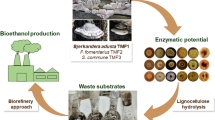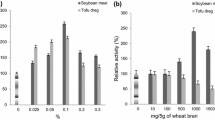Abstract
Laccase has the ability to act on a broad range of substrates, as a result of which multiple compounds have been used for laccase assay and numerous applications have been discovered over time. Thus, considering the above points, in the present study, white and blue laccase from Myrothecium verrucaria ITCC-8447 and Pleurotus ostreatus were used for laccase assay using various substrates which includes 2,2′ azinobis-3-ethylbenzothiazoline-6-sulfonic acid (ABTS), 2,6-dimethoxyphenol (2, 6 DMP), guaiacol (GCL), and syringaldazine (SYZ). The most effective substrate of the four substrates was ABTS for white and blue laccase. The white and blue laccase were further used for the synthesis of bio-material via fungal-assisted treatment of wheat bran (WB) and sugarcane bagasse (SB) followed by micro-wave pre-treatment and the addition of starch and glycerol to the treated agro-residue in the ratio of 5:1:1. The thickness swelling and water absorption percentage was minimum for wheat bran synthesized bio-material using white laccase in comparison to the other synthesized bio-material.
Access this chapter
Tax calculation will be finalised at checkout
Purchases are for personal use only
Similar content being viewed by others
References
Hattori M, Konishi H, Tamura Y et al (2005) Laccase-type phenoloxidase in salivary glands and watery saliva of the green rice leafhopper, Nephotettix cincticeps. J Insect Physiol 51(12):1359–1365
Surwase SV, Patil SA, Srinivas S et al (2016) Interaction of small molecules with fungal laccase: a surface plasmon resonance based study. Enzym Microb Technol 82:110–114
Martinez AT, Ruiz-Duenas FJ, Martinez MJ, del Rio JC, Gutierrez A (2009) Enzymatic delignification of plant cell wall: from nature to mill. Curr Opin Biotechnol 20:348–357
Karp SG, Faraco V, Amore A, Letti LAJ, Thomaz Soccol V, Soccol CR (2015) Statistical optimization of laccase production and delignification of sugarcane bagasse by Pleurotus ostreatus in solid-state fermentation. Biomed Res Int 2015:1–8
Afreen S, Anwer R, Singh RK et al (2016) Extracellular laccase production and its optimization from Arthrospira maxima catalyzed decolorization of synthetic dyes. Saudi J Biol Sci 25:1446–1453
Olga VKS, Elena VS, Valeria PG, Olga VM, Natalia VL, Aida ND, Alexander IJ, Alexander M (1998) Purification and characterization of the constitutive form of laccase from basidiomycete Coriolus hirsutus and effect of inducers on laccase synthesis. Biotechnol Appl Biochem 28:47–54
Eichlerová I, Šnajdr J, Baldrian P (2012) Laccase activity in soils: considerations for the measurement of enzyme activity. Chemosphere 88(10):1154–1160
Bourbonnais R, Paice M, Reid I et al (1995) Lignin oxidation by laccase isozymes from Trametes versicolor and role of the mediator 2, 2′-azinobis (3-ethylbenzthiazoline-6-sulfonate) in Kraft lignin depolymerization. Appl Environ Microbiol 61(5):1876–1880
Wu J, Kim KS, Lee JH et al (2010) Cloning, expression in Escherichia coli, and enzymatic properties of laccase from Aeromonas hydrophila WL-11. J Environ Sci 22(4):635–640
Jolivalt C, Madzak C, Brault A et al (2005) Expression of laccase IIIb from the white-rot fungus Trametes versicolor in the yeast Yarrowia lipolytica for environmental applications. Appl Microbiol Biotechnol 66(4):450–456
Rajagopalu D, Show PL, Tan YS et al (2016) Recovery of laccase from processed Hericium erinaceus (Bull.: Fr) Pers. fruiting bodies in aqueous two-phase system. J Biosci Bioeng 122(3):301–306
Holme DJ, Peck H (1996) Resolución de Problemas de Bioquímica Analítica, first ed. Acribia, Zaragoza 160:114–126
Lowry OH, Rosebrough NJ, Farr AL et al (1951) Protein measurement with the Folin phenol reagent. J Biol Chem 193(1):265–275
Verma P, Watanabe T, Honda Y, Watanabe T (2011) Microwave-assisted pretreatment of woody biomass with ammonium molybdate activated by H2O2. Bioresour Technol 102(4):3941–3945
Jeefferie AR, Fariha ON, Warikh AR, Yuhazri MY, Sihombing H, Junid R (2011) Preliminary study of the physical and the mechanical properties of tapioca starch/sugarcane fiber cellulose composite. J Eng Appl Sci 6(4):7–15
Author information
Authors and Affiliations
Corresponding author
Editor information
Editors and Affiliations
Rights and permissions
Copyright information
© 2020 Springer Nature Singapore Pte Ltd.
About this chapter
Cite this chapter
Agrawal, K., Verma, P. (2020). Laccase-Mediated Synthesis of Bio-material Using Agro-residues. In: Sadhukhan, P., Premi, S. (eds) Biotechnological Applications in Human Health. Springer, Singapore. https://doi.org/10.1007/978-981-15-3453-9_10
Download citation
DOI: https://doi.org/10.1007/978-981-15-3453-9_10
Published:
Publisher Name: Springer, Singapore
Print ISBN: 978-981-15-3452-2
Online ISBN: 978-981-15-3453-9
eBook Packages: Biomedical and Life SciencesBiomedical and Life Sciences (R0)




